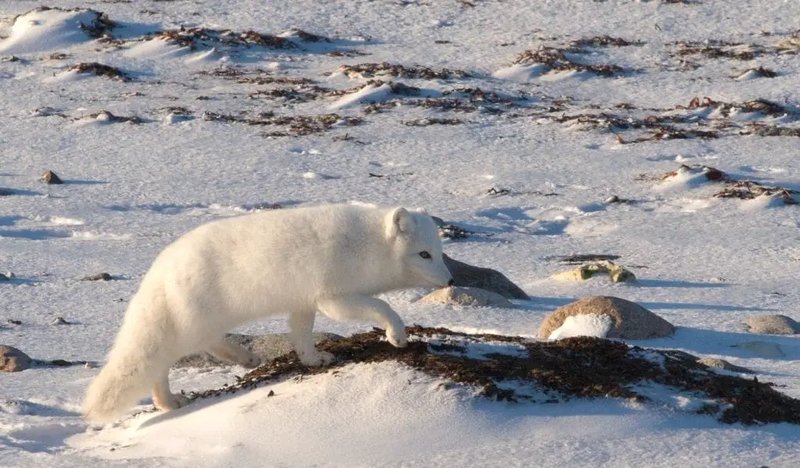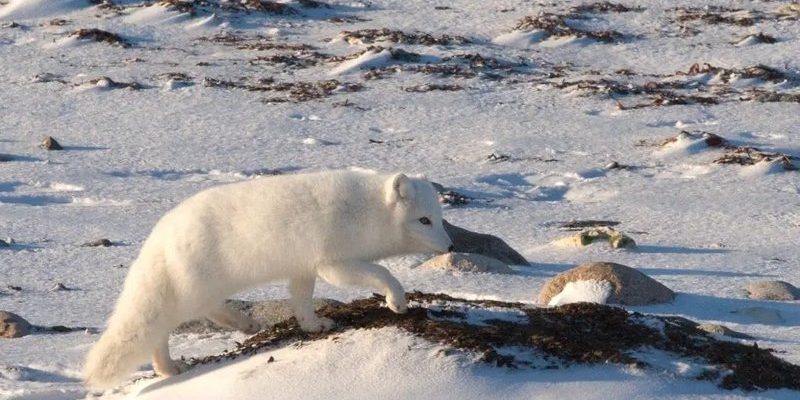
Imagine living in a place where it’s freezing cold, food is scarce, and every day feels like a survival challenge. For the Arctic fox, this is everyday life. They’ve developed unique strategies not just to find food but to stay alive. Whether it’s their clever hunting methods or their opportunistic eating habits, these foxes show us just how well life can adapt to even the toughest conditions.
The Arctic Fox’s Diet: What Do They Eat?
The Arctic fox is classified as an omnivore, which means they eat both plants and animals. Their diet is primarily made up of small mammals, such as lemmings and rodents, but it doesn’t stop there. Here’s a closer look at what makes up their meals.
Seasonal Variations in Diet
The Arctic fox adapts its diet based on the season. In summer, when food is more abundant, they feast on:
- Lemmings: These small rodents are like the Arctic fox’s bread and butter. They’re plentiful during summer.
- Birds: Eggs and chicks are a tasty treat, especially when lemmings are less available.
- Fruits and Berries: During the warmer months, they snack on berries like crowberries and blueberries.
In winter, however, the options get a lot tougher. The snow can cover up the ground, making hunting more challenging. The Arctic fox often relies on:
- Carrion: They’re scavengers at heart. Eating the leftovers of larger animals, like seal carcasses, becomes a vital food source.
- Stored Food: They’ll bury extra food they find in the summer to snack on during the winter months.
The Importance of Adaptability
One of the incredible things about the Arctic fox is its ability to adapt. You might be wondering how a fox can survive when food choices change so drastically. Well, they’re not picky eaters! Their flexible diet allows them to thrive when conditions aren’t ideal. This adaptability is crucial because, in the Arctic, you’ve got to be ready for anything.
Hunting Strategies: How Do They Catch Their Food?
Hunting in the Arctic isn’t just about speed; it’s about clever strategies. The Arctic fox employs various techniques to catch its prey.
The Pounce Technique
One of the most fascinating methods is the pounce technique. Picture this: the fox spots a lemming under the snow and immediately crouches down, lowers its body, and gets ready to leap. When the time is right, it jumps high into the air, landing right on top of its target. This method not only helps them break through the snow but also surprises their unsuspecting prey.
Teamwork in Hunting
While Arctic foxes are often solitary hunters, they sometimes work together. When hunting larger prey, like birds or rabbits, they may join forces. This teamwork increases their chances of success, allowing them to corner or confuse their target. It’s a great example of how they can adapt their strategies based on the situation.
Tools of the Trade: Senses and Skills
A successful hunt depends not just on technique but also on the fox’s remarkable senses. Let’s dive into what makes them such effective hunters.
Exceptional Hearing
The Arctic fox has incredible hearing. They can detect the rustling of small animals under the snow, even when it’s several feet thick. This ability allows them to pinpoint their prey, giving them an edge during the hunt. It’s fascinating how nature equips these animals with the tools they need to survive in a challenging environment.
Camouflage
Another clever twist in their hunting strategy is their camouflage. During the winter, their fur changes to a bright white, blending perfectly with the snow. This helps them sneak up on their prey without being detected. In summer, their fur turns a brown or gray color, which keeps them hidden among the rocks and tundra.
The Role of Scavenging
Hunting isn’t the only way Arctic foxes find food; they’re also expert scavengers. In a land where every calorie counts, scavenging plays a significant role in their diet.
Following Larger Predators
The Arctic fox often follows larger predators like polar bears, waiting for a chance to snag leftover scraps. When a polar bear catches a seal, the fox is right there, ready to take advantage of the situation. This is a smart strategy, maximizing their food sources without putting in the energy to hunt.
Opportunistic Eating Habits
You might think of the Arctic fox as a picky eater, but they’re far from it. Their opportunistic nature means they’ll eat whatever’s available. Whether it’s fish, berries, or scraps from a human camp, if it’s edible and within reach, they’ll go for it. This adaptability not only helps them survive but thrive in their harsh environment.
The Impact of Climate Change
Unfortunately, the Arctic fox’s survival is threatened by climate change. The warming climate affects their habitat and food sources, making life even more challenging.
Loss of Sea Ice
As sea ice melts, the larger animals they rely on for scavenging are impacted. This affects the food chain, making it harder for Arctic foxes to find food. With fewer seals available, they may struggle to survive.
Changing Ecosystem Dynamics
With the changing climate, the dynamics of the ecosystem are shifting. New competitors, like red foxes, are moving into the Arctic fox’s territory, which can lead to increased competition for limited food resources. This added stress can affect their hunting success and overall population.
The Arctic fox is a true survivor, demonstrating remarkable adaptability and ingenuity. From their varied diet that changes with the seasons to their clever hunting strategies, these foxes show us the beauty of nature’s resilience.
As we watch these little hunters navigate the Arctic landscape, it reminds us that survival is all about being resourceful and flexible. In a world where challenges are ever-changing, the Arctic fox stands as a testament to the power of adaptation. Knowing more about their diet and strategies not only deepens our appreciation for them but also highlights the urgent need to protect their habitat. After all, every creature on this planet has a role to play, and sometimes, that role is to teach us how to adapt, just like the Arctic fox.

